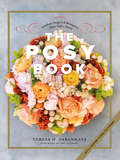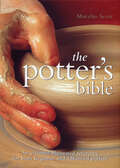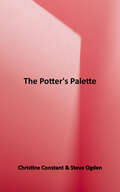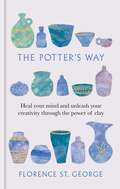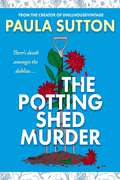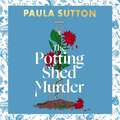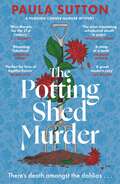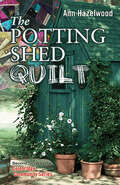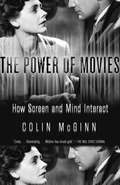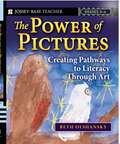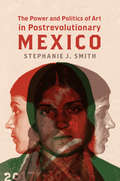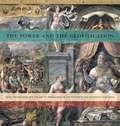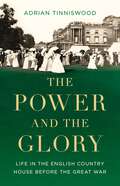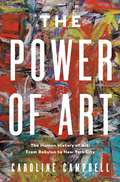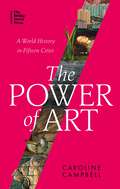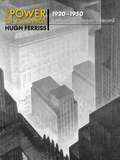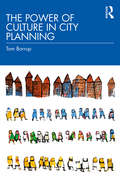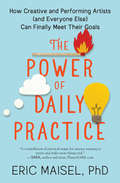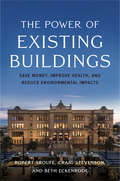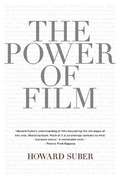- Table View
- List View
The Posy Book: Garden-inspired Bouquets That Tell A Story
by Teresa H. Sabankaya“Like a favorite recipe, a posy is meant to be savored and shared. Try it yourself, and … welcome a bit of floral enchantment into your life.” —Amy Stewart, author of The Drunken Botanist Inspired by the Victorian-era language of flowers, a posy is a small, round bouquet of flowers, herbs, and plants meant to convey a message, such as dahlias for gratitude, sunflowers for adoration, or thyme for bravery. These floral poems have become Teresa Sabankaya’s signature. Brides want them for their weddings, but a posy is a lovely gift any time of year, and one that readers can easily put together from their garden or with blooms from their local florist. In The Posy Book, Sabankaya shares step-by-step instructions, floral recipes for more than 20 posies, and ideas for seasonal variations. A modern floral dictionary, with 12 original paintings by celebrated illustrator Maryjo Koch, will help readers craft their own posies filled with personal meaning.
The Pot That Juan Built
by Nancy Andrews-GoebelJuan Quezada creates pots in the traditional style of the Casas Grandes people. This real-life story relays how Juan's pioneering work has changed a poor village into a prosperous community.
The Potter's Bible: An Essential Illustrated Reference for Both Beginner and Advanced Potters (Artist/craft Bible Ser.)
by Marylin ScottAn essential guide for beginner and advanced potters, featuring step-by-step photographs to guide you through a comprehensive range of techniques.Begin making beautiful ceramics, even if you’ve never attempted pottery before, following detailed information about:Essential tools and studio equipmentDifferent types and constituencies of clay—including earthenware, stoneware, porcelain, and rakuForming methods—including pinching, coiling, slabbing, press molding, throwing, and trimmingAdding texture and patterns—with techniques such as sgraffito, stamping, inlaying, and burnishingPainting and printing—using slip, banding and combing, resists, and underglazesGlazes and post-firing techniques—including salt and soda glazes, lusters, and metal leafEssential technical resources—such as glaze recipes, types of kilns and firings, and health and safety tipsWith its combination of practical advice, exciting images, inspirational ideas, and a glossary, this book is a must-have for all potters at any stage of their career.
The Potter's Palette: A Practical Guide to Creating Over 700 Illustrated Glaze and Slip Colors
by Christine Constant Steve OgdenNever again suffer the uncertainty of mixing a color and getting an entirely different fired result. This reference walks the potter through glaze circulation, formulation, and use. Includes color bars to show fired results.
The Potter's Way: Heal your mind and unleash your creativity through the power of clay
by Florence St. George'Warm, honest and full of inspiring tips, Florence's story shows us that pottery has the power to soothe the heart and heal the mind.' JULIA SAMUEL, author of Grief Works and This Too Shall PassSometimes, the smallest things lead to the biggest changes. When struggling with depression and feeling lost after the birth of her daughter, Florence St. George began experimenting with a lump of clay on her kitchen table. Pot by pot, bowl by bowl, she discovered that as her hands became busier, her mind grew calmer. In just a few years, Florence went from complete beginner to contestant on The Great Pottery Throw Down, learning what clay has to teach along the way: that creativity doesn't have to be expensive, that pottery is the perfect antidote to internet overload and that working with clay can ground you like nothing else.In The Potter's Way, Florence shares her tips on how to get started on your own pottery journey, from hand-building pinch pots to throwing large-scale vessels on the wheel. This captivating book invites us all to slow down, reflect and experience the transformative power of creativity.'I have found nothing outside myself that can truly fill the void, but this book demonstrates that pottery is about as close as it gets.' NICK LOVE, film director and writer
The Potter's Way: Heal your mind and unleash your creativity through the power of clay
by Florence St. George'Warm, honest and full of inspiring tips, Florence's story shows us that pottery has the power to soothe the heart and heal the mind.' JULIA SAMUEL'An honest and redemptive story about the power of fun and creativity - I've always said if it was mandatory to wear a smock once a week and get messy with clay, adults would be happier.' MIRANDA HARTSometimes, the smallest things lead to the biggest changes. When struggling with depression and feeling lost after the birth of her daughter, Florence St. George began experimenting with a lump of clay on her kitchen table. Pot by pot, bowl by bowl, she discovered that as her hands became busier, her mind grew calmer. In just a few years, Florence went from complete beginner to contestant on The Great Pottery Throw Down, learning what clay has to teach along the way: that creativity doesn't have to be expensive, that pottery is the perfect antidote to internet overload and that working with clay can ground you like nothing else.In The Potter's Way, Florence shares her tips on how to get started on your own pottery journey, from hand-building pinch pots to throwing large-scale vessels on the wheel. This captivating book invites us all to slow down, reflect and experience the transformative power of creativity.'I have found nothing outside myself that can truly fill the void, but this book demonstrates that pottery is about as close as it gets.' NICK LOVE'This book is a journey, with a map. Like all maps, it relay's history, from the first point of contact to pivotal moments along the way. I like a map. They help us to find our way.' INDIA HICKS
The Potting Shed Murder (A Hill House Vintage Murder Mystery)
by Paula SuttonFrom the creator of Hill House Vintage and &“Queen of Cottagecore&” (Vogue), a fresh, witty, fun, and delightfully quirky cozy crime novel set in a seemingly sleepy English village for fans of Richard Osman, Parini Shroff, Benjamin Stevenson, and Anthony Horowitz. &“Miss Marple for the 21st Century.&” ―S.J. Bennett, author of The Windsor KnotWelcome to the beautiful, bucolic village of Pudding Corner, where there's death amongst the dahlias . . . Daphne Brewster has gladly swapped south London for Pudding Corner, a Norfolk hamlet full of quintessentially English charm. With a mix of stone cottages, Georgian architecture, and Victorian Gothic houses all nestled together and surrounded by fields of gold and green, Pudding Corner and its neighboring village of Pepperbridge seem as far from the bustle of city living as one can get. For Daphne, joy at moving into beautiful Cranberry Farmhouse with her husband, James, and their three young children is tempered by some concerns about being the only Black woman for miles around. But within a few short months, Daphne has become known as the parish&’s &“Vintage Lady&” and has set up her own shop. Business is thriving, and so is her family. As for Pudding Corner, it&’s rapidly revealing itself to be filled with complicated, intertwined lives on par with anything she left behind. Then the local school&’s headmaster is found dead in his allotment patch, unleashing a storm of secrets and scandal. Even a sleepy village has its social hierarchy, and as her new friend, Minerva, becomes a target of whispers and speculation, Daphne can&’t resist getting involved. Fighting for the underdog comes as naturally as sourcing the perfect vintage piece. But there is more at stake here than Daphne could have guessed, and a killer who has succeeded once is all too willing to try again . . .
The Potting Shed Murder: A totally unputdownable cosy murder mystery (Hill House Vintage Murder Mysteries)
by Paula SuttonThe debut cosy crime novel by cottage-core queen and social-media sensation Paula Sutton, the creator of Hill House Vintage.Welcome to the beautiful, bucolic village of Pudding Corner, where there's death amongst the dahlias...Newly arrived in the quaint village of Norfolk's Pudding Corner, Daphne Brewster is glad to be leaving London life behind. As time goes by, and she finds herself in great demand as the village's unofficial Vintage Lady, she begins to acclimatise to this new, more sedate way of life.But when the village school's headmaster is discovered dead, lying face down in his allotment patch, everything changes. His wife refuses to accept a verdict of natural causes, and the village is suddenly ablaze with scandal about 'the potting shed murder'. When the headmaster's influential widow points her finger at Minnerva, Daphne's new friend, the fingers of the village begin to point with her.As the unjust politics and machinations of power in a sleepy rural village slowly become apparent to her, Daphne decides to clear her friend's name, and begins to investigate...A deliciously addictive and quirky whodunnit, perfect for fans of Agatha Christie's classic murder mysteries, and page-turners by Janice Hallett and Richard Osman.(P) 2024 Little Brown Book Group Limited for and on behalf of Dialogue Books
The Potting Shed Murder: A totally unputdownable cosy murder mystery (Hill House Vintage Murder Mysteries)
by Paula Sutton'Miss Marple for the 21st Century. Loved it. A must-read' S.J. Bennett, author of The Windsor KnotWelcome to the sleepy village of Pudding Corner, a quintessentially English haven of golden cornfields, winding cobbled lanes ... and murder.Daphne Brewster has left London behind and is settling into her family's new life in rural Norfolk, planting broad beans in raised beds and vintage hunting for their farmhouse. But when the local headmaster is found dead in his potting shed, amongst his allotment cabbages, the village is ablaze: Who would kill beloved Mr Papplewick, pillar of the community? Daphne soon comes to realise perhaps the countryside isn't so idyllic after all...When the headmaster's widow points her finger at Minnerva, Daphne's new friend, Daphne vows to clear her name. Sneaking into the crime scene and chasing down rumours gets her into hot water with the local inspector - until she comes across a faded photograph that unearths a secret buried for forty years... They say nothing bad ever happens in close-knit Pudding Corner, but Daphne is close to the truth - dangerously close...There's death amongst the dahlias... A truly unputdownable whodunnit by Paula Sutton - otherwise known as Instagram's happiest influencer: Hill House Vintage, the queen of cottagecore - an unforgettable new voice in cosy crime. Perfect for fans of Richard Osman, Janice Hallett and Richard Coles.'Blooming fabulous! The perfect book to get lost in . . . The cosiest of cosy crime' Veronica Henry'A village of secrets, a cast of zany characters: this is a romp of a read that warms the heart' Orlando Murrin, author of Knife Skills for Beginners 'A really fun, fast-paced and atmospheric whodunnit. Perfect for fans of Agatha Raisin' Jessica Bull, author of Miss Austen Investigates'Begs to be read in the cosiest of spaces' Tasha Coryell, author of Love Letters to a Serial Killer'A great modern cosy' Ian Moore, author of Death and Croissants'Delightful . . . Charming and fresh' Kuchenga Shenjé, author of The Library Thief'I absolutely loved it! Utterly absorbing. Daphne is such a brilliant protagonist, I couldn't help but love her. And that twist!' Lisa Hall, author of The Mysterious Double Death of Honey Black'The most wholesome whodunit I've ever read . . . I loved it!' Stephanie Yeboah'Such a fun cosy crime mystery with a really exciting ending! I hope that we're going to see Daphne solving more crimes in the future!' Kate Weston, author of You May Now Kill the Bride 'A quintessentially English murder mystery. Paula Sutton brings a new voice to the cosy genre with her fresh take and witty twist on modern village life. Vintage crime!' Jo Furniss, author of Dead Mile'An utterly delightful whodunnit unfolds in this pitch-perfect cosy mystery. Absolutely glorious!' Victoria Dowd, author of The Smart Woman's Guide to Murder'Beautiful, mesmerising and immensely satisfying, The Potting Shed Murder shows us how even the most idyllic places can hide secrets. Rich in detail and bursting with warmth, I read this book well into the night, finding myself unable to put it down. Sutton is a master storyteller' Awais Khan, author of No Honour and Someone Like Her
The Potting Shed Murder: A totally unputdownable cosy murder mystery (Pudding Corner Murder Mysteries)
by Paula Sutton'Miss Marple for the 21st Century. Loved it. A must-read' S.J. BENNETTWelcome to the sleepy village of Pudding Corner, a quintessentially English haven of golden cornfields, winding cobbled lanes ... and murder.Daphne Brewster has left London behind and is settling into her family's new life in rural Norfolk, planting broad beans in raised beds and vintage hunting for their farmhouse. But when the local headmaster is found dead in his potting shed, amongst his allotment cabbages, the village is ablaze: Who would kill beloved Mr Papplewick, pillar of the community? Daphne soon comes to realise perhaps the countryside isn't so idyllic after all...When the headmaster's widow points her finger at Minnerva, Daphne's new friend, Daphne vows to clear her name. Sneaking into the crime scene and chasing down rumours gets her into hot water with the local inspector - until she comes across a faded photograph that unearths a secret buried for forty years... They say nothing bad ever happens in close-knit Pudding Corner, but Daphne is close to the truth - dangerously close...There's death amongst the dahlias... A truly unputdownable, twist-packed whodunnit that is perfect for fans of Richard Osman, Janice Hallett and Richard Coles.'Reminiscent of Poirot . . . Daphne Brewster is easily the most interesting whodunnit sleuth in year' Paterson Joseph'Blooming fabulous! The perfect book to get lost in . . . The cosiest of cosy crime' Veronica Henry'A village of secrets, a cast of zany characters: this is a romp of a read that warms the heart' Orlando Murrin, author of Knife Skills for Beginners 'A really fun, fast-paced and atmospheric whodunnit. Perfect for fans of Agatha Raisin' Jessica Bull, author of Miss Austen Investigates'Begs to be read in the cosiest of spaces' Tasha Coryell, author of Love Letters to a Serial Killer'A great modern cosy' Ian Moore, author of Death and Croissants'Delightful . . . Charming and fresh' Kuchenga Shenjé, author of The Library Thief'I absolutely loved it! Utterly absorbing. Daphne is such a brilliant protagonist, I couldn't help but love her. And that twist!' Lisa Hall, author of The Mysterious Double Death of Honey Black'The most wholesome whodunit I've ever read . . . I loved it!' Stephanie Yeboah'Such a fun cosy crime mystery with a really exciting ending! I hope that we're going to see Daphne solving more crimes in the future!' Kate Weston, author of You May Now Kill the Bride 'A quintessentially English murder mystery. Paula Sutton brings a new voice to the cosy genre with her fresh take and witty twist on modern village life. Vintage crime!' Jo Furniss, author of Dead Mile'An utterly delightful whodunnit unfolds in this pitch-perfect cosy mystery. Absolutely glorious!' Victoria Dowd, author of The Smart Woman's Guide to Murder'Beautiful, mesmerising and immensely satisfying, The Potting Shed Murder shows us how even the most idyllic places can hide secrets. Rich in detail and bursting with warmth, I read this book well into the night, finding myself unable to put it down. Sutton is a master storyteller' Awais Khan, author of No Honour and Someone Like Her
The Potting Shed Quilt (Colebridge Community Series)
by Ann HazelwoodThe author of The Basement Quilt delivers a novel of mystery, romance—and ghosts!—as flower shop owner Anne Brown searches for a place to call home. The second saga of Anne Brown and the Colebridge Community! In The Basement Quilt, the debut novel by Ann Hazelwood, you got to know the family and friends of Anne Brown, a plucky florist whose daily ups and downs are as familiar as your own. In this follow-up book, Anne and her fiancé, Sam, start house-hunting, or is that haunting? Once again, a quilt holds keys and clues to important family secrets, but whose family is it this time? And why would anyone hide a quilt in a potting shed? Life continues apace for Anne’s family and friends, too. Share in their joys and sorrows as Colebridge goes about every community’s business. The Potting Shed Quilt is not just the title of this sequel—the quilt itself is a character. You’ll want to meet other quilt “characters” throughout the series.Praise for Ann Hazelwood and the Colebridge Community Series“I found myself immersed in the tale of this extended family and this wonderful quaint town . . . You will laugh, cry and share in their hopes and dreams.” —Community News“Ann Hazelwood knows a few things about the human spirit, family and dreaming big. Add a mixture of the love of quilting and all the things Missouri historic and otherwise; you will experience the words and passion of this unique and gifted author. Enjoy the experience!” —StreetScape Magazine
The Power Of Movies
by Colin McginnHow is watching a movie similar to dreaming? What goes on in our minds when we become absorbed in a movie? How does looking “into” a movie screen allow us to experience the thoughts and feelings of a movie’s characters? These and related questions are at the heart ofThe Power of Movies,a thoughtful, invigorating, and remarkably accessible book about a phenomenon seemingly beyond reach of our understanding. Colin McGinn–“an ingenious philosopher who thinks like a laser and writes like a dream,” according to Steven Pinker–enhances our understanding of both movies and ourselves in this book of rare and refreshing insight.
The Power Of Pictures: Creating Pathways To Literacy Through Art, Grades K-6
by Beth OlshanskyIn The Power of Pictures book and companion DVD, Beth Olshansky introduces teachers to her innovative art-based approach to literacy instruction. Widely practiced in classrooms across the country, the model has been proven by research to improve literacy achievement with a wide range of learners, especially those who struggle with verbal skills. At the heart of her approach is the Artists/Writers Workshop. Through study of quality picture books and hands-on art experiences, students learn to visualize, “paint pictures with words,” and ultimately create their own extraordinary artistic and literary work. The book and DVD explain how any teacher can successfully use this process to enable all students, particularly low performers, to make dramatic gains in...
The Power and Politics of Art in Postrevolutionary Mexico
by Stephanie J. SmithStephanie J. Smith brings Mexican politics and art together, chronicling the turbulent relations between radical artists and the postrevolutionary Mexican state. The revolution opened space for new political ideas, but by the late 1920s many government officials argued that consolidating the nation required coercive measures toward dissenters. While artists and intellectuals, some of them professed Communists, sought free expression in matters both artistic and political, Smith reveals how they simultaneously learned the fine art of negotiation with the increasingly authoritarian government in order to secure clout and financial patronage. But the government, Smith shows, also had reason to accommodate artists, and a surprising and volatile interdependence grew between the artists and the politicians. Involving well-known artists such as Frida Kahlo, Diego Rivera, and David Alfaro Siqueiros, as well as some less well known, including Tina Modotti, Leopoldo Mendez, and Aurora Reyes, politicians began to appropriate the artists' nationalistic visual images as weapons in a national propaganda war. High-stakes negotiating and co-opting took place between the two camps as they sparred over the production of generally accepted notions and representations of the revolution's legacy—and what it meant to be authentically Mexican.
The Power and the Glorification: Papal Pretensions and the Art of Propaganda in the Fifteenth and Sixteenth Centuries
by Jan L. de JongFocusing on a turbulent time in the history of the Roman Catholic Church, The Power and the Glorification considers how, in the fifteenth and sixteenth centuries, the papacy employed the visual arts to help reinforce Catholic power structures. All means of propaganda were deployed to counter the papacy’s eroding authority in the wake of the Great Schism of 1378 and in response to the upheaval surrounding the Protestant Reformation a century later. In the Vatican and elsewhere in Rome, extensive decorative cycles were commissioned to represent the strength of the church and historical justifications for its supreme authority. Replicating the contemporary viewer’s experience is central to De Jong’s approach, and he encourages readers to consider the works through fifteenth- and sixteenth-century eyes. De Jong argues that most visitors would only have had a limited knowledge of the historical events represented in these works, and they would likely have accepted (or been intended to accept) what they saw at face value. With that end in mind, the painters’ advisors did their best to “manipulate” the viewer accordingly, and De Jong discusses their strategies and methods.
The Power and the Glorification: Papal Pretensions and the Art of Propaganda in the Fifteenth and Sixteenth Centuries
by Jan L. de JongFocusing on a turbulent time in the history of the Roman Catholic Church, The Power and the Glorification considers how, in the fifteenth and sixteenth centuries, the papacy employed the visual arts to help reinforce Catholic power structures. All means of propaganda were deployed to counter the papacy’s eroding authority in the wake of the Great Schism of 1378 and in response to the upheaval surrounding the Protestant Reformation a century later. In the Vatican and elsewhere in Rome, extensive decorative cycles were commissioned to represent the strength of the church and historical justifications for its supreme authority. Replicating the contemporary viewer’s experience is central to De Jong’s approach, and he encourages readers to consider the works through fifteenth- and sixteenth-century eyes. De Jong argues that most visitors would only have had a limited knowledge of the historical events represented in these works, and they would likely have accepted (or been intended to accept) what they saw at face value. With that end in mind, the painters’ advisors did their best to “manipulate” the viewer accordingly, and De Jong discusses their strategies and methods.
The Power and the Glory: Life in the English Country House Before the Great War
by Adrian TinniswoodA spirited history of the English country house in its golden age For generations, the great palaces of Britain were home to living histories, noble families that had reigned for centuries. But by the end of the nineteenth century, members of elite society found themselves, for the first time, in the company of arrivistes. Their new neighbors—from chorus girls to millionaire greengrocers to guano impresarios—lacked lineage and were unencumbered by the weight of tradition. In The Power and the Glory, historian Adrian Tinniswood reconstructs life in the country house during its golden age before the Great War, when Britain ruled over a quarter of the earth&’s population and its stately homes were at their most opulent. But change was on the horizon: the landed classes were being forced to grapple not only with new neighbors, but also with new social norms and expectations. An exuberant story, The Power and the Glory offers a delicious, captivating, and often scandalous history of the British country house.
The Power of Art: A Human History of Art: From Babylon to New York City
by Caroline CampbellAn epic work of art history that will transform our understanding of the world by unlocking the human stories behind millennia of art. Taking readers from ancient Babylon to contemporary Pyongyang, the eminent curator Caroline Campbell explains art's power to illuminate our lives—and inspires us to benefit from its transformative and regenerative power. Unlike the majority of contemporary art history, this book is about much more than the cult of artists&’ personalities. Instead, each chapter is structured around a city at a particularly vibrant moment in its history, describing what propelled its creativity and innovation. The emotions and societies she evokes are highly recognizable, revealing how great art resonates powerfully by transcending the boundaries of time.
The Power of Art: A World History in Fifteen Cities
by Caroline CampbellTHE POWER OF ART is an epic work of non-fiction that will transform our understanding of the world by unlocking the human stories behind millennia of art. Taking readers from ancient Babylon to contemporary Pyongyang, the eminent curator Caroline Campbell explains art's power to illuminate our lives, and inspires us to benefit from its transformative and regenerative power.Unlike the majority of art history, this book is about much more than the cult of personality. Instead, each chapter is structured around a city at a particularly vibrant moment in its history, describing what propelled its creativity and innovation. The emotions and societies she evokes are recognisable today, showing how great art resonates powerfully by transcending the boundaries of time.
The Power of Art: A World History in Fifteen Cities
by Caroline CampbellTo read most histories of art, you might be forgiven for supposing that great artists are superhuman, and the knowledge of different movements, periods and styles is essential to truly appreciate art.It's time to look at art in a new way.THE POWER OF ART delves into the stories behind remarkable acts of creation in fifteen global cities at pivotal moments of artistic brilliance. It shows how art is an integral part of our daily lives, embedded in the very fabric of our existence. From the enduring wonders of ancient Babylon to the menacing pastel architecture of contemporary Pyongyang, eminent curator Caroline Campbell intertwines the stories of artists with the broader social, cultural and political landscapes of their time.In each vivid episode, Campbell reveals how art, in all its forms, is a testament to humanity's inventiveness and ingenuity: it has served our fundamental needs for shelter, sustenance, spirituality, pleasure, order and community. But it can also evoke envy, anger, greed, and even be used as a means of social control.Spanning thousands of years of creativity, THE POWER OF ART will ignite your imagination and open your eyes to the art that surrounds us, whether it be a painting in a gallery, a public sculpture or an everyday object with hidden beauty.
The Power of Buildings, 1920-1950: A Master Draftsman's Record
by Hugh FerrissTrained as an architect in the early twentieth century, Hugh Ferriss possessed a vision of form that surpassed the traditional blueprints of his peers--and it showed in his distinctively moody renderings. A master of light and shadow, he managed to capture the spirit of each building with a heightened sense of perspective and design. By the 1920s, he was well on his way to becoming America's greatest architectural draftsman. Ferriss' remarkable style, which influenced generations of builders, is highlighted in this illustrated journey through three decades of American architecture.Accompanied by illuminating text and captions, this collection of sixty of his extraordinary drawings includes: Rockefeller Center, a stunning symbol of modern Art Deco style; California's Shasta Dam, ranked as one of the great civil engineering feats of the world; the Perisphere and Trylon from New York's 1939 World's Fair; Taliesin-in-Arizona, Frank Lloyd Wright's breathtaking winter home; and Denver's Red Rocks Amphitheater, a dramatic structure that incorporates natural elements and rock formations. Plus, there are illustrations of the Empire State Building, the United Nations headquarters, airports, grain elevators, bomb shelters, and more. Architects, draftsmen, and designers of all ages will savor the wonder and imagination in this magnificent volume.
The Power of Culture in City Planning
by Tom BorrupThe Power of Culture in City Planning focuses on human diversity, strengths, needs, and ways of living together in geographic communities. The book turns attention to the anthropological definition of culture, encouraging planners in both urban and cultural planning to focus on characteristics of humanity in all their variety. It calls for a paradigm shift, re-positioning city planners’ "base maps" to start with a richer understanding of human cultures. Borrup argues for cultural master plans in parallel to transportation, housing, parks, and other specialized plans, while also changing the approach of city comprehensive planning to put people or "users" first rather than land "uses" as does the dominant practice. Cultural plans as currently conceived are not sufficient to help cities keep pace with dizzying impacts of globalization, immigration, and rapidly changing cultural interests. Cultural planners need to up their game, and enriching their own and city planners’ cultural competencies is only one step. Both planning practices have much to learn from one another and already overlap in more ways than most recognize. This book highlights some of the strengths of the lesser-known practice of cultural planning to help forge greater understanding and collaboration between the two practices, empowering city planners with new tools to bring about more equitable communities. This will be an important resource for students, teachers, and practitioners of city and cultural planning, as well as municipal policymakers of all stripes.
The Power of Daily Practice: How Creative and Performing Artists (and Everyone Else) Can Finally Meet Their Goals
by Eric MaiselLearn the #1 Secret of the Most Successful Pros: Daily Practice Eric Maisel knows from experience and observation that the single most crucial element of success for any endeavor is a regular, daily practice. Dr. Maisel, a preeminent creativity coach, therapist, and acclaimed author, shows how and why to implement a daily practice and addresses common challenges. His experience working with bestselling writers, entrepreneurs, musicians, actors, visual artists, recovering addicts, and rehabilitation patients shows as he outlines various ways to approach a daily practice and goes on to help you build a version of this important discipline that suits your life and goals. Real-world stories and practical examples will help you make measurable progress and build satisfaction in your most cherished pursuits.
The Power of Existing Buildings: Save Money, Improve Health, and Reduce Environmental Impacts
by Robert Sroufe Jr Craig Stevenson Beth EckenrodeYour building has the potential to change the world. Existing buildings consume approximately 40 percent of the energy and emit nearly half of the carbon dioxide in the US each year. In recognition of the significant contribution of buildings to climate change, the idea of building green has become increasingly popular. But is it enough? If an energy-efficient building is new construction, it may take 10 to 80 years to overcome the climate change impacts of the building process. New buildings are sexy, but few realize the value in existing buildings and how easy it is to get to "zero energy&” or low-energy consumption through deep energy retrofits. Existing buildings can and should be retrofit to reduce environmental impacts that contribute to climate change, while improving human health and productivity for building occupants. In The Power of Existing Buildings, academic sustainability expert Robert Sroufe, and construction and building experts Craig Stevenson and Beth Eckenrode, explain how to realize the potential of existing buildings and make them perform like new. This step-by-step guide will help readers to: understand where to start a project; develop financial models and realize costs savings; assemble an expert team; and align goals with numerous sustainability programs. The Power of Existing Buildings will challenge you to rethink spaces where people work and play, while determining how existing buildings can save the world. The insights and practical experience of Sroufe, Stevenson, and Eckenrode, along with the project case study examples, provide new insights on investing in existing buildings for building owners, engineers, occupants, architects, and real estate and construction professionals. The Power of Existing Buildings helps decision-makers move beyond incremental changes to holistic, results-oriented solutions.
The Power of Film
by Howard SuberThis book examines the patterns and principles that make films popular and memorable, and will be useful both for those who want to create films and for those who just want to understand them better.
